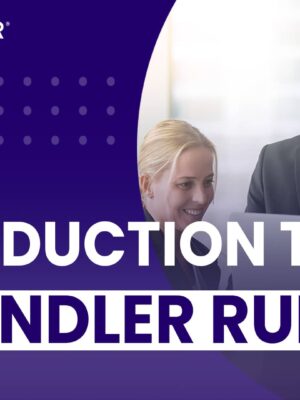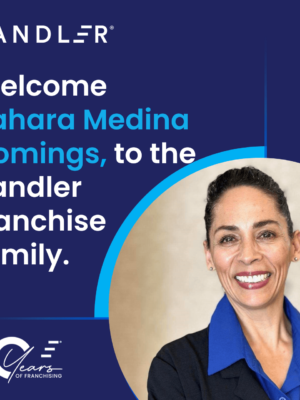How to Succeed at Cold Prospecting
Listen to the podcast:
How to Succeed at Cold Prospecting
Mike Montague: Welcome to the How To Succeed Podcast. The show that helps you get to the top and stay there. This is How to Succeed at Cold Prospecting. The show is brought to you by Sandler Training, the worldwide leader in sales management and customer service training. For more information on Sandler Training, including white papers, webinars and more, visit Sandler.com.
I’m your host Mike Montague and my guest this week is Sean Coyle. He is one of our corporate Sandler trainers and one of our professional prospectors. So we’re going to talk with him about how to succeed at cold prospecting.
Sean, welcome to the show. Tell me a little bit about cold prospecting and why should people be paying attention today.
Sean Coyle: Yeah. Thanks for having me on Mike. Yeah. It’s a pretty important topic and I think the folks that ought to be paying attention, are those that have the primary responsibility to actually fill the top of their funnel via picking up the telephone and having meaningful conversations with appropriate targets. I think we should also have the leaders paying attention. As a means to help them coach their folks and hold them accountable to really doing the right types of activities, the right way. And if you get in front of the right types of prospects, you know, right time, right place for the right reasons.
Mike Montague: Yeah. And I think with the rise of social media and everything, there’s a lot of marketers out there bashing cold calling and cold prospecting and things. And trying to spout the benefits of inbound marketing, which is great. And they’re really good at getting that message out, but in my mind, I always think that, what if there’s somebody that won’t call you? Like, does that mean you’re never going to sell them? There still has to be some sort of cold prospecting in your mix. You shouldn’t probably be doing all of cold prospecting, but maybe that’s your job too. So how do you balance that with today’s modern marketing and selling?
Sean Coyle: That’s interesting. And you do see a lot of that messaging out there, but you know … cold calling and cold prospecting is dead. In my opinion, my experiences, the exact opposite is actually true. We have a lot of these tools out there. You’ve got social media, you’ve got inbound and outbound marketing programs, really at anybody’s finger tips at any given point in time, at any price point. I think these things help and they can make you more efficient, but it doesn’t eliminate the need to actually pick up the phone and create a human to human interaction.
I think one of the ways that an organization or an individual can truly differentiate themselves is by actually picking up the phone and having that conversation with the right type of a target for the right types of reasons. Although those tools are valuable and I think assist sales people and leaders, they don’t replace the necessity to pick up a phone and make outbound calls. And I completely agree with what you say. I don’t think that you need to only make cold calls or only do social media or only do something. I think as you build a plan for success, as it relates to filling the top of your funnel, you should have a good mix. And that mix should incorporate gaining referrals and introductions and going to networking events and leveraging centers of influence and responding to inbound leads and running outbound packs of campaigns. But I think another important component of that is still picking up the phone and having a conversation with the prospects for the reasons that you want to have a conversation with them.
Mike Montague: Yeah. And I think the other part of that is it really depends on what type of business or role you’re in. Because if you’re doing a business to consumer, you sell to homeowners, maybe cold calling is not the right thing for you. Or door knocking is not the right thing for you. But if you’re calling on B to B customers that are not doing other things or not actively participating in your marketing program, you might have to pick up the phone or go see them and have these conversations.
So let’s get into it and talk about attitude a little bit here. What is the ideal attitude for cold prospecting? And then, maybe, what are one or two that we should avoid?
Sean Coyle: Yeah. So, if you really think about … Maybe I’ll start with what we should avoid. If you think about the idea of just prospecting and most specifically, cold prospecting, we’re doing something that’s quite frankly very unnatural to us as human beings. And it’s unnatural in many cases based on how we were raised. And I’d remember as a child, being told by my parents, things like, “Good little boys and girls are seen, but not heard.” “Don’t talk to strangers.” “Stop asking so many question.” You know, as I look back, my parents weren’t attempting to keep me from being a successful salesperson. They were trying to keep me in the line as a 6-7-8 year old. But over a period of time, those messages actually will stick. And they stick in the subconscious.
So if you really think about the idea of picking up the phone and calling a complete stranger and asking them questions, and perhaps you’re even suggesting to them that they make some form of a commitment to you, it’s a very unnatural act. And it creates moments for individuals to engage in what I call creative avoidance activities. So we may have defined for ourselves, you know, I have to make so many calls and have so many conversations and book so many appointments. But in the moment, I might make a decision to re-write a proposal. Or I might make a decision to help somebody else in the office next to me. Or I might make a decision to do something that perhaps may be more difficult, but certainly less emotionally taxing. So I think part of what good prospectors need to really work through is, in some cases, overcoming some of those childhood messages that will at times paralyze us and cause us to engage, again as I said, in those creative avoidance activities.
You know, and one of the things I have found to be most helpful in changing my belief system around prospecting, because to this day, I still find it unnatural and uncomfortable, obviously necessary. But I think a good mindset is to really realize that your prospecting activities are a scavenger hunt. And, you know, there’s no risk or frustration associated with a scavenger hunt. You’re out looking for something.
And another way for me to think about it is, how I would use what I call a gumball machine analogy. So think about a gumball machine. It’s a large transparent globe, but it’s populated with hundreds, if not thousands, of multicolored gumballs. And as we grew up, we all had our favorite gumball and my favorite color was green. You know, there were purple ones and there were red ones and when I went and put my coin into the gumball machine and turned the dial, I knew I couldn’t make a green one come out. I may have attempted. I may have shaken the machine. I may have crossed my fingers. But at the end of the day, I knew I couldn’t force a green gumball to come out.
And so as I turned the dial and I opened the flap, here comes a purple gumball. Well I didn’t like the purple gumball. So I would simply hand it to my little brother, who I also didn’t like. And I would put in another coin and turn the dial and boom, out comes a red gumball. Well, the red gumballs were not my favorites. And so I’d throw that one in the garbage. And then I’d put in a coin and turn the dial and out comes my green gumball.
And so I think that how people need to think about their prospecting activities is … You know, the world you prospect into, whether it’s a niche marketplace or a massive community, you can see that population of prospects, because they are transparent. We know how to gain information and gain access to people. And we can also realize that we know our green gumballs are in that gumball machine. I can see them. But I also know there’s purple ones and I know there’s red ones. And so when I turn the dial or in this case, when I pick up the phone and make an outbound call, I have to realize that it is a bit of a scavenger hunt. And I’m just waiting to see what happens.
And I have to use that conversation, not to try to turn somebody from a purple gumball into a green one, but use that conversation to decide what color gumball they are and then act accordingly. So I think that’s a great message or belief system to have, is that, the world I’m prospecting to is a gumball machine. And I’m not always going to get my green gumballs, but I know they’re there and eventually they’ll come out if I just keep turning the dial.
Mike Montague: Yeah. I think that’s brilliant. And really, it takes all of the pressure off of you to convince somebody to change their color. When really what you’re trying to do is uncover what color they are. You just want to get them on the phone so you can see if they’re green or red and then act accordingly. So let’s talk about how we do that behavior wise. What is our goals, plans, and actions?
Sean Coyle: So I think it’s really about building a blueprint for success. I think part of that blueprint for success … It has to incorporate a couple of key performance indicators or metrics. And I think the two in my option and experience that are most valuable really center around, number one, setting a goal for meaningful conversations and I put some boundaries, if you will, around what I would consider to be a meaningful conversation. I think a meaningful conversation is a conversation that’s being had with an individual who can make a decision or significantly influence the decision on the product or service that my business is out there selling in the marketplace.
I think the second boundary I would place on what I would consider to be a meaningful conversation is that, the purpose of my conversation is to at least attempt to initiate some form of a business development event. I doesn’t mean that I will. And by the way, a business development event is booking in appointments. Whether it’s a 30 minute conference call or a 90 minute face to face meeting or something in between, it’s basically booking the start of your sales process in whatever way you would do that in your business. So I think it’s got to be with a person who’s a decision maker or close to a decision maker. And the purpose of the conversation is to really attempt to initiate that first step in your process. So I think meaningful conversations are critical. I think we should have goals for those on a daily, if not weekly basis.
The second key performance indicator or metric for success would revolve around appointments booked. First appointments booked with prospects that are initiating, again, that business development event. And so, if I can combine meaningful conversations and first time appointments booked, I can kind of work my goals backwards. You know, I can decide the sources that these conversations and appointments will come from. You know, what percentage will come from cold calls versus networking events versus center of influence conversations versus referrals and introductions.
You know, and I can kind of work my matrix out based on the sources of these metrics. But I think at the end of the day, I’ve got to set goals for conversations and appointments. I need to have a tracking mechanism in place, whether it be paper thermometers hanging in my office or a white board with a makeshift spreadsheet drawn on it or some form of an app or an electronic application that helps me real time track this information. So I have to have goals. I have to have a mechanism to track these goals. And then I have to seek some accountability and that accountability can come from my manager. It can come from a peer. It can come from somebody that cares about my success. But at the end of the day, I think it’s important for people to have goals, create a tracking mechanism for those goals, and then be held accountable on a consistent basis.
Mike Montague: So I think we need to move over to technique because I know a lot of people want to know, how do you do this. And there’s a lot of mystery around it. I think if people haven’t ever done it. But I know professional sales people generally figure out how to start and hold these conversations. And I love how you qualified those as meaningful business opportunity sales conversations. That’s really what we’re looking for. How do we start a good cold prospecting call?
Sean Coyle: There’s really no magic bullets, if you approach it the right way. And what I mean by that is, you have to remember that it is a conversation. And it’s a conversation with another person. And certainly from a cold perspective, we have to realize that perhaps we have even disrupted or interrupted this individual that we’re attempting to have a conversation with in the middle of something. But they did pick up. And so I think the first thing we need to understand is to engage in a conversation and be natural. Be yourself. Be the person that people in your life respond to. And not some overly odd or hyper-professional version of yourself.
So from a tactical perspective, think the most important thing for people to remember is, you are you, so be yourself on that call. Now, in that, I think it’s also important to follow a conversational template and have an objective to the call and not ramble on and be “I” centered or point fingers at your prospect. And so I think from an approach prospective, the same thing happens every time.
A prospect picks up the phone, and they say hello. And that’s when the conversation begins. And we can capture their attention, certainly not by launching into a pitch and talking about our company, and the reason that we’ve called, but in fact do the opposite and slow things down. And I hear a lot of sales people that use the telephone, even effectively, tend to want to rush through that call.
And I think it’s important that we want to slow things down a bit. And we can slow it down by simply saying, “Good morning.” Or “Good afternoon, Mike. Sean Coyle.” And pause for a moment and let them catch up to the conversation. And then at that point they engage with you, right? Then a conversation is ebb and flow. Back and forth. We extract and extend information in a good conversation. And so what we want to do in a prospecting call is very similar. I want to have an ebb and a flow.
“You know Michael, I’m not sure if my name is at all familiar to you. Why don’t I take a moment and share the purpose for my call. And perhaps in the next couple of seconds, you can decide if there’s value in a separate conversation. And if there is, maybe we schedule some time with each other. If there’s not, you know what, feel free to politely kick me to the curb.”
And so I want to stage a quick agenda so that once we’ve got them paying attention, also let them know that this is going to be a very short concise and quick conversation. And at that point, I now want to create some context for my call. I want to introduce the company that I’m representing or the service that I want to introduce to them and perhaps a little bit of meaningful high level background information.
“You know Michael, the bottom line for my call is my company is Sandler Training. We’re a sales and sales leadership training organization.” I don’t have to go into greater detail than that. And then from here I want to extend some third party observations. And those observations may be as simple as, “Mike, we work a lot with mid-size accounting firms. And when I talk to my leaders in these firms they share this problem or that problem or the other problem. And I guess my next question to you, Michael, is the prospect is whether or not those problems are relevant and worth a conversation.”
And so I want to have a fluid tone. I want to be myself in the call. I want to follow that structure. You know, slow things down. Create a bit of an agenda around expectations. Create some context. Share some third party observations. And then really at that point, let the prospect vote. Is it a conversation that they think is relevant and valuable to have? If so, we’ll let nature take its course. If it’s not, it’s completely fine as well. They can kick me to the curb. They’re a purple or a red gumball and I can move on to my next conversation.
Mike Montague: Yeah. I like all of that, but especially the, “Be yourself.” Because I think it’s so funny. If you put a sales person in a room, and you said, “Call your best friend right now and just have a conversation. See what they’re up to.” They’d say, “Hey Sean. How’s it going?” That’s how they’d start the conversation. And you say, “Dial a prospect.” And they go, “Hey Mr. Coyle. I was wondering if …” And then all of a sudden it’s a totally different conversation in the first 30 seconds just because of who they’re calling. And I think if you really can train yourself to relax and just be yourself and take all of that pressure off.
So, it’s so funny. I think just doing that could make a huge difference in your cold prospecting calls, but then I loved the agenda you laid out too. The set some sort of agenda for the call. Let them know what’s happening so they can put their guard down and relax. Tell them a little bit about the problems you solve and then qualify them. See if they have any of those problem. Right?
Sean Coyle: Yeah. And keep it simple. I think there’s repeatability and power and comfort in simplicity. And if we try to over complicate the conversation, I think we end up making our lives too complicated. And we put pressure on ourselves to perform perfectly in every given moment. We also place undue pressure on our prospects to respond in the way that we want them to respond.
You know, in my opinion, that’s really not the best way to approach these calls.
Mike Montague: Love it. And another take away I heard from yours is, you didn’t say anything about actually selling anything. You said, et it take its course or set another appointment. Reschedule a call. Your goal on these are to set conversations that are scheduled then, to have those sales discussions. Not to get a yes in these 3 minutes on the phone with a prospect.
Sean Coyle: Yeah. I think a very common mistake … And I don’t think it’s conscious. I don’t think it’s purposeful, but I think one of the more common mistakes that sales people can make is, they try to treat the prospecting call like a sales call. And we do have to understand in just how we speak about it. Prospecting calls are prospecting calls. Sales calls are sales calls. Let’s not blur the line.
The purpose of a prospecting call is to have that conversation, initiate an event. You know, booking an appointment or another conversation. The purpose of a sales call is to really extract greater information from the person that we are attempting to do business with and figure out what type of commitments they’re willing and able to make to solve the problems that they’ve shared with us. These are two different scenarios.
My prospecting call was to certainly, only figure out, on the surface are they my green gumball. And if they are, I should be investing some more time with them. If they’re not, I can move on to somebody else.
Mike Montague: Awesome man. Again, we’re talking with Sean Coyle today. He’s one of our corporate Sandler trainers. Been in the Sandler network for quite a long time and is now one of our professional prospectors as well. Sean, how do you define success for yourself?
Sean Coyle: You know, I think it’s a combination really of 3 things. I think it’s having a commitment to do the right activities and be consistent with prospecting behaviors or questioning strategies or the development of certain skill sets. So I think one is being committed to a cause and being committed to a blueprint for success.
Mike Montague: Awesome. And what was the biggest lesson learned or hurdle you had to get over in your career?
Sean Coyle: I think it really has been overcoming many of those youth messages. The things that we’ve heard growing up and the things that we probably, even in my case, even make the mistake to say to my own children. And realize that anything that’s happening in the sales process isn’t happening to us or to harm us or to help us. It simply happens. And so I think being able to really eliminate and kind of water down some of the emotional involvement has been just a significant lesson and continues to be a lesson.
Mike Montague: Yeah. I like that, but I still get emotionally involved when I get the white gumball. I don’t even know what flavor that is. That’s not flavor.
Sean Coyle: No question, but the white gumball didn’t put itself in your hand to upset you. Right? I just simply got there. And I think that the big lesson.
Mike Montague: And what’s your superpower and the origin story about how you got it? What do you lean on when you need to be successful? What’s your go to move?
Sean Coyle: It’s an interesting question, because even as I was growing up I was a bit of a comic book or a closet comic book aficionado, if you will. And I think if I had a superpower, it would be plagiarism. And I mean that in the most positive sense. My … Anybody’s ability to really copy a successful process and successful approaches has probably been my best superpower over the 20 plus years in sales. Learning from others and being able to incorporate best practices into my own approach.
Mike Montague: I like it. Pablo Picasso said, “Good artists create. Great artists steal.” So you can steal that quote from him next time you need to talk about it. What is your favorite Sandler rule?
Sean Coyle: Oh my goodness. There’s so many of them out there. I think … And I’m not even sure it would be an official Sandler rule, but it’s, “Don’t let the way you feel dictate the way you act. But rather, let the way you act dictate the way you feel.” And again, that’s just a common theme around what we even talked about here. And it’s really detaching yourself from the emotional involvement.
Celebrate the activity and celebrate your commitment and conviction and consistency and ultimately, if you’re doing it right and you’re doing consistently, the outcomes will come that are supposed to come. So I think it’s, don’t focus on the outcome, focus on the process. Don’t let your feelings dictate what you think you should do or not do next. Simply do them and do them as best as you can. And then allow that to shift your belief systems.
Mike Montague: Yeah. That one is an official rule. I believe that one is in the sales book. So let’s wrap everything up for everybody. Based on cold prospecting, Sean, what is one attitude you would like people to have leaving the podcast?
Sean Coyle: I think the most important attitude is to realize the potency that you as an individual are bringing to your marketplace. It is your right. It is, in many cases, your prospect’s privilege to extend information to them. And so I think it’s critical that people realize and work very hard at remembering that they are bringing a potency to the marketplace. And I think if you can believe that or at least act as if you believe that, it can change in a positive way everything else that you’re doing around prospecting.
Mike Montague: And one key behavior to do?
Sean Coyle: I think, find an accountability partner. And set your goals, track your goals, and then ask somebody to consistently hold you accountable at doing the right things and not allow you to make excuses for avoiding the things that are not comfortable for you to do around your prospecting activities.
Mike Montague: And the best technique to use?
Sean Coyle: Be yourself. Realize that this is a human to human interaction and you want to have a conversation. And I think you referenced it earlier. Remind yourself what you sound like when you call somebody you’re comfortable with and be that person on the telephone. Because that’s who your prospects will respond to, is the natural version of who you are.
Mike Montague: Sean, thanks for being on the show. For more on this topic, we have a whole bunch of resources for you. You can check out our book, Prospect the Sandler Way, at https://www.sandler.com/shop. We also have a brand new online course that you can check out, hosted by Sean Coyle himself. And he will also be on a special webinar coming up. So if you are listening to this in time, here in the first couple of weeks, you still have time to register for our, Prospecting Best Practices webinar.
Just go to Sandler.com, click on the resources tab and then look for the webinars. And you can join us for a special hour long session with me and Sean diving in deeper on this topic and figuring out how we can get you to prospecting success. As always, thank you for listening and remember you can leave us a review at iTunes or Google Play. And whatever you are, be a good one. The hottest succeed podcast is brought to you by Sandler Training, the worldwide leader in sales management and customer service training for individuals all the way up to fortune 500 companies with over 250 locations. For more information on Sandler Training, visit Sandler.com.
Sean Coyle and Mike Montague will be hosting an hour long webinar on Cold Prospecting on Sept 19th. Register for free here: https://reports.sandler.com/webinar-09192017-no-pressure-prospecting/
If you would like to learn more about Sandler Training, contact a local trainer: https://www.sandler.com//freesession








